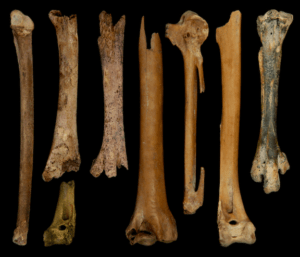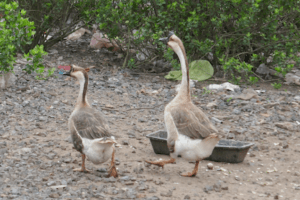
PROCEEDINGS OF THE NATIONAL ACADEMY OF SCIENCES—Researchers report evidence of geese domestication in China 7,000 years ago. The history of poultry domestication is less well understood than that of mammalian livestock. Masaki Eda and colleagues performed histological, geochemical, biochemical, and morphological analyses on goose bones from a 7,000-year-old rice cultivation village in the Yangtze River valley in China to uncover evidence of early domestication. The study region is a wintering site for wild geese with no current breeding activity, and the authors found immature goose bones in the archaeological assemblage. Oxygen isotope analysis helped identify bones belonging to nonmigratory, locally bred geese. Biochemical analysis suggested that the diet of local geese differed from migratory geese and may have included cultivated rice. Morphological analysis suggested that local geese were kept for multiple generations, given that they had a consistent body size compared with wild geese. Together, the bones, which were radiocarbon dated to 7150–6670 years ago, exhibited signs of early goose domestication. Based on butchering and manufacturing marks on the bones, the authors suggest that geese were locally bred to meet the demand for meat and bone tool materials when wild, migratory geese were unavailable. According to the authors, the results suggest that early goose domestication may have preceded chicken domestication.
__________________________________

Modern Chinese domestic geese (Anser cygnoides domesticus). Masaki Eda.
__________________________________

Goose bones found at Tianluoshan, China. Masaki Eda.
__________________________________
Article Source: PNAS news release.
“Multiple lines of evidence of early goose domestication in a 7,000-y-old rice cultivation village in the lower Yangtze River, China,” by Masaki Eda, Yu Itahashi, et al., Proceedings of the National Academy of Sciences, 7-Mar-2022. https://www.pnas.org/cgi/doi/10.1073/pnas.2117064119
__________________________________
Advertisement


